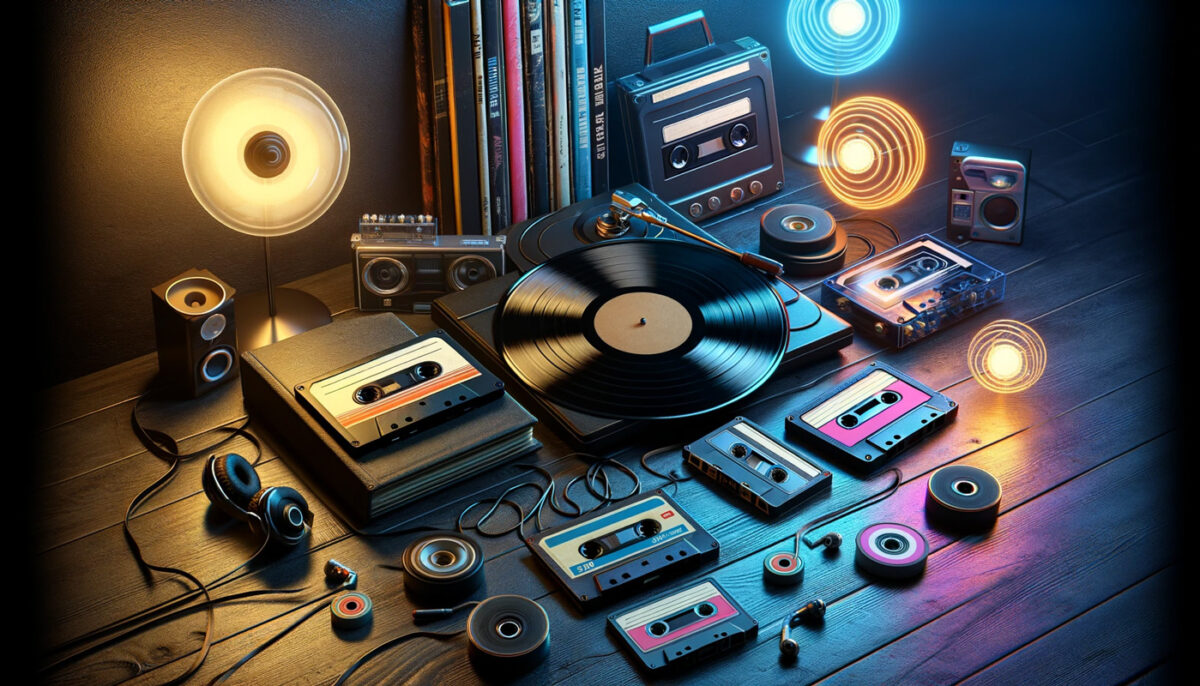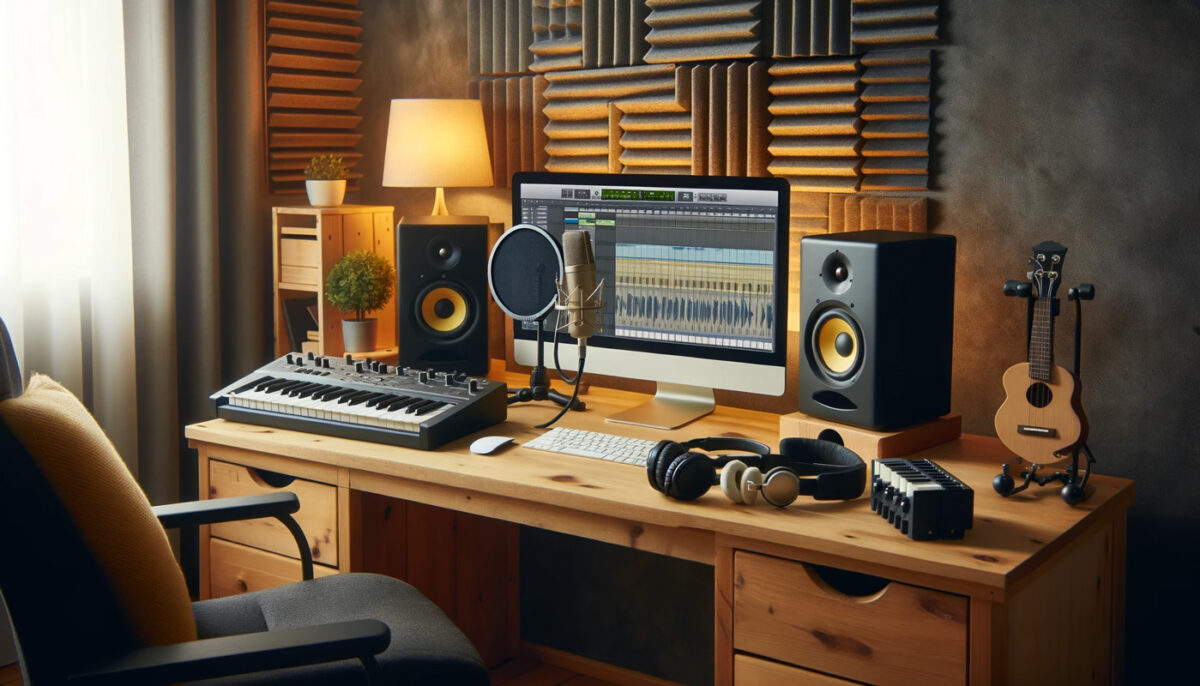
As we tune into 2024, the music industry continues to resonate with plenty of innovation and transformation. But, what exactly does the next iteration of this bustling industry look like? What lies ahead of us? Where the future is always a bit of a mystery, there are some strong indicators on music industry trends we can expect to see over the next year. Let’s look at nine music predictions – from genre evolution to tech revolutions.
Jump to these sections:
- The rise of genre fluidity
- A renaissance of physical music formats
- The AI revolution in music creation
- Personalized music consumption
- Advancements in live performance technology
- Exploration of 3D audio and spatial sound
- The boom of the home studio
- Increased use of blockchain in the music industry
- Monetizing music in new ways
Explore the future of music with the new tools included in Komplete Start, the free bundle of instruments, sounds, and plugins that can help you create music with a professional sound.
1. The rise of genre fluidity
The future of popular music is full of innovation and diversity. The era of strict genre boundaries is fading, giving way to a dynamic and fluid musical world. What does this mean for the music we’ll be hearing in 2024 and beyond? The current trajectory – where more artists are seeking to express their diverse influences and listeners have a growing appetite for novel, cross-genre experiences – could lead to a complete breakdown of the way we’ve always tried to classify our musical libraries.
As we’ve seen over the past decade or so, genre boundaries are not just being blurred – they’re being redrawn. Artists are increasingly refusing to be pigeonholed, leading to a creative explosion across genres. Fusion genres, blending elements of folk, EDM, and hip hop, are emerging as the new norm. This trend is reshaping what we consider “popular music,” making the future an exciting, unpredictable symphony.
2. A renaissance of physical music formats
Vinyl and cassettes, those beloved relics of the past, are making a triumphant return in 2024. As someone who grew up visiting record shops and building my own prized collection, I can testify that there’s something irreplaceable about the tactile and nostalgic experience they offer, a sentiment echoed in the resurgence of their popularity.

This trend speaks volumes about how humans are looking for a more tangible, authentic musical experience in an overwhelmingly digital era. It’s like we’re all seeking a deeper connection with our music, a yearning for the days of album art and liner notes. This isn’t just me musing over old records; the numbers back it up. The global vinyl record market, valued at $1.8 billion in 2023, is on a steady climb and projected to hit $3.4 billion by 2032. For more insight into this vintage revival, feel free to check out this detailed analysis on the vinyl record market.
3. The AI revolution in music creation
The ethical debate surrounding AI in music creation is a complex one. On one side, there’s the argument that AI challenges creativity, posing the question: can true artistic expression arise from algorithms and machine learning? On the flip side, proponents of AI in music see it as a tool that enhances creativity, opening up new possibilities and allowing artists to explore uncharted sonic territories. They argue that AI doesn’t replace human creativity but rather augments it, serving as a collaborator rather than a replacement. Regardless of where you stand on this debate, one thing is clear: AI in music is here to stay as part of the industry’s future.
AI-powered music plugins demonstrate how technology can be a boon for musicians, streamlining workflows without compromising artistic integrity. These tools can analyze and suggest chord progressions, assist in mixing and mastering, and even help in sound design, making the technical aspects of music production more efficient. They can even teach you about complex techniques in audio engineering before empowering you with the tools to do the work yourself.
This efficiency enables artists to focus more on the creative part of their work, fostering an environment where technology supports rather than overtakes the creative process. The bottom line: AI’s role in music production (and promotion) is expanding rapidly and, as we move toward the future, it will only become more useful and more accessible to artists and producers.
4. Personalized music consumption
In today’s music scene, personalization is king. Streaming services like Spotify and Apple Music are changing the game, offering playlists that feel like they’ve been handpicked just for us. It’s not just about musical preferences anymore – these platforms cater to our moods, activities, and even throw in surprises we never knew we’d love. This evolution, driven by sophisticated data analytics and the rise of AI, is helping to make every music experience feel intimately personal.
Each time I log into Spotify, I find a playlist that seems to understand me better than I do myself – it’s a whole new world of music discovery and enjoyment.
This is another sign we’re likely living in the end of days for “genre sorting.” After all, in the past, they were just the signposts guiding us to the right section of a record store. But now, in the era of streaming, these boundaries are becoming virtually nonexistent. My AI-made playlists effortlessly blend jazz, pop, techno, hip hop, and plenty more – transcending traditional genre classifications.
It seems that genres, once crucial for marketing albums, are becoming obsolete in our personalized, genre-defying musical landscape, which makes it an extremely exciting time for music lovers. Our tastes are not just being catered to, but also expanded in ways we never imagined.
5. Advancements in live performance technology
Live performances are becoming more immersive than ever, especially with advancements in AR and VR technology. These innovations are allowing artists to create unique, interactive concert experiences that go beyond traditional boundaries. This shift is driven by new technological advancements and a growing demand for novel, engaging live experiences.
An excellent example of this innovation is the new Sphere venue in Las Vegas. As the world’s largest spherical structure, this venue offers an unparalleled concert experience. Its use of immaculate audiovisual technology creates a completely immersive environment for the audience (and the performers). The Sphere’s design integrates seamless audio and high-resolution visuals, allowing for an intimate connection between the artist and the audience in a way that transforms the traditional concert experience. This venue represents a significant leap in live performance technology, offering a glimpse into the future of live music experiences.
6. Exploration of 3D audio and spatial sound
As a producer obsessed with interesting sound design, I’ve been really excited about the advancements in 3D audio and spatial sound. One of the big music trends in 2024 that we’re going to see is this corner of the industry blowing up. It’s not just about listening to music anymore – it’s about experiencing it in a completely new way.
The THX Spatial Creator plugin from Plugin Alliance, for instance, has been a game-changer in my own audio projects. It allows me to add immersive audio elements to my music, creating a fully 3D sound experience. It’s truly amazing how it enhances the depth and dimension of any sound, bringing each piece of audio to life in a really unique and engaging way.
7. The boom of the home studio
Having worked in a home studio for the past 16 years, I’ve personally witnessed its evolution and growing significance in the music industry. The home studio boom, particularly as we step into 2024, is more than just a trend – it’s a reflection of a major shift in how music is created and produced. With advancements in technology making high-quality tools more affordable and accessible, musicians learning how to produce music can craft professional-grade music right from their homes. This newfound accessibility of music producing tools isn’t just empowering artists worldwide – it’s also redefining music industry trends, making the art of creating music more personal and intimate than ever.

My journey in my home recording studio has been a testament to the creative freedom and flexibility that this setup offers. It’s amazing how the barriers to enter the music industry have lowered just in my lifetime, allowing for a more diverse range of voices and styles to emerge. As we continue through 2024, the home studio won’t just be a continuing trend, but as a staple in music production, fostering a new generation of artists who bring fresh perspectives and sounds to the industry.
8. Increased use of blockchain in the music industry
As someone who’s navigated the complexities of the music industry for years, the rise of blockchain technology is a development I’m particularly intrigued by. Thanks to the Music Modernization Act, it’s already revolutionizing the way we handle music rights and royalty management, bringing a much-needed layer of transparency and efficiency to the music industry.
In my own experience, understanding and managing royalties can be incredibly challenging. With more artists and labels now adopting blockchain technologies, there’s a tangible shift towards a system that empowers artists by ensuring fairer and more timely compensation. And this trend isn’t just a technological fad. It’s a crucial response to the long-standing issues that have plagued the music industry in the digital era.
As we move forward, this potential to redefine how artists are paid for their work not only sounds promising, but is also indicative of a broader movement towards fairness and clarity in the industry.
9. Monetizing music in new ways
In my journey through the music industry, there has been a significant shift in how artists monetize their work. The digital era has opened up a ton of avenues beyond traditional album sales and live performances. Today, we’re looking at a landscape where artists can leverage streaming platforms, sell digital merchandise, and even engage in direct-to-fan marketing.
As an artist, I’ve experienced firsthand the potential of these new revenue streams. And it’s really empowering to have control over how and where my music reaches listeners. Platforms like Bandcamp, Patreon, and even music NFTs offer unique opportunities to monetize my music while still maintaining artistic integrity. And I believe this shift is crucial for independent artists who seek to carve out a sustainable career in the dynamic landscape of the music industry. As we move through 2024, it’s going to become extra clear that the future of music monetization is richly diverse and full of possibilities.
This evolution in monetization strategies is not just about diversifying income streams – it’s about connecting with audiences in innovative ways and tapping into new markets. The key, though, is to explore these options creatively and strategically. For more info on how to make a living from your music, check out my article: 25 ways to make money with music.
Start creating music for the future
As we look ahead, it’s clear that 2024 is set to be a landmark year in the music industry. From genre-bending compositions to groundbreaking technological advancements, the possibilities are as limitless as they are exciting. Whether you’re just starting to make music or a seasoned pro, there’s never been a better time to dive into music creation.
To kickstart your journey, download Komplete Start for free access to a suite of top-notch production tools. It’s time for us to start making the music of the future.















